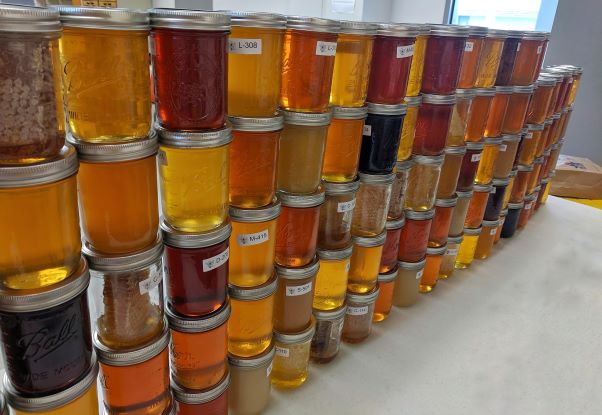Why is honey different colors?
Have you noticed that honey comes in different shades? Have you wondered why that is? In this post I would like to inform you what the different colors, tastes and honey texture means. You will also discover the benefits of raw honey and why not all honey is created equal.
POLLINATION
The main reason you can expect to find different shades of honey is because of the plants the bees are pollinating. Different flowers equals different shades of honey. Simple enough, but here is where it gets sticky…
STORAGE
When honey is stored for a long time, sometimes it can change colors. Fresh honey is usually more liquid and cloudy in color. Once it sits for a while, it changes to a more opaque color, and the honey texture gets hard (crystallizes) and can become more light or dark in color.
PROCESSING
The other factor to consider is if you have raw unprocessed honey or processed honey (pasteurized). When the honey is heated at a high temperature it turns amber in color and is clear. This is why you often see the same color honey on the shelves of a common grocery store. Processed honey loses its nutritional value as it is stripped of all pollen through an ultra filtering process. Raw honey will always vary in color and texture and retains all of its health benefits.
Why is my honey crystalized?
Have you bought a delicious jar of honey form the market, only to find that it got hard and crystally after just a few weeks? I have come to find that a lot of people get to this point and assume their honey has gone bad.
PROCESSED VS RAW
Before your throw out your honey, let me assure you that crystalized or hard honey is actually a good sign. This often means that your honey is raw. In fact, pasteurized honey does not crystalize quickly, if at all. The processed honey is heated to over 160 degrees breaking down the crystals. The remaining crystals are then filtered out and sometimes sugar and water are also added. This process insures a longer liquid shelf life. I would like to inform you or remind you, that quality honey does not have an expiration date. So if you have honey that has gone hard or crystalized, this is perfectly normal. In fact, it is a good sign that your honey is raw and unfiltered, which is a major factor in why we consume it in the first place.
HONEY TEXTURES
You will also find that not all raw honey crystalizes the same. Some honey gets sharp, hard and big crystals, while others get smaller and creamier crystals. Some honey takes a while to get hard, while others take only weeks. The texture of your honey depends on the different plants the bees are foraging. The nectar from different flowers has varying levels of glucose and fructose. Honey with higher glucose crystalizes faster and often is creamier, while honey with higher fructose often takes longer to crystalizes forming larger, harder crystals.
HOW CAN I KEEP MY HONEY LIQUID?
Some people simply do not like their honey hard, for this reason, I would like to share some tips for keeping your honey liquid. First, consider the temperature, honey crystallizes faster in a colder climate. Fresh honey stored in the fridge will get hard and creamy because honey which crystallizes fast has smaller crystals creating a creamy texture. In short, keeping your honey in 80 degree temperatures will ensure its liquid form for a long time.
Now for most people, keeping their supply of honey in such warm conditions may not be realistic. For this reason, there are some ways to gently heat your honey so that is does not lose its nutritional benefits. One way is to leave it in the hot sun for a while. Another way to heat honey, is to put the jar in a sink full of hot water. Finally, an instapot/ pressure cooker with a yogurt setting keeps the contents warm at about 110 degrees. The bees keep the temperature in their hive close to 98 degrees. So heating your honey up to 110 degrees will still keep all those nutrients in tact.
Can honey vary in Flavor?
The answer to the above questions is, yes! However, if you are not a regular honey consumer, you may find in difficult to distinguish the difference between the many flavors of honey.
FORAGING
The bees forage nectar from different flowers in bloom, thus pollinating the plants through the process. So, if a hive of bees is in a field of apple blossoms, the honey will be mostly apple blossom honey. If a hive of bees is in a peach orchard, the flavor of the honey will taste different than apple blooms. A hive that is set up around plants which bloom in different seasons will have a slightly new flavors with each harvest depending on what is in bloom. When you go to the store this is why you see labels that say “macadamia nut honey” or “cherry blossom honey”.
PROCESSING
Not to bring up processed honey again, but when honey is heated and processed, it loses its unique flavor. This especially happens in honey that gets sugar and water added to it. The flavor becomes more of a sugar syrup consistency. I like to call it “the grocery store flavor.” In conclusion, it is safe to say that the best way to consume honey is in its purest, raw form, straight from your favorite beekeeper!

